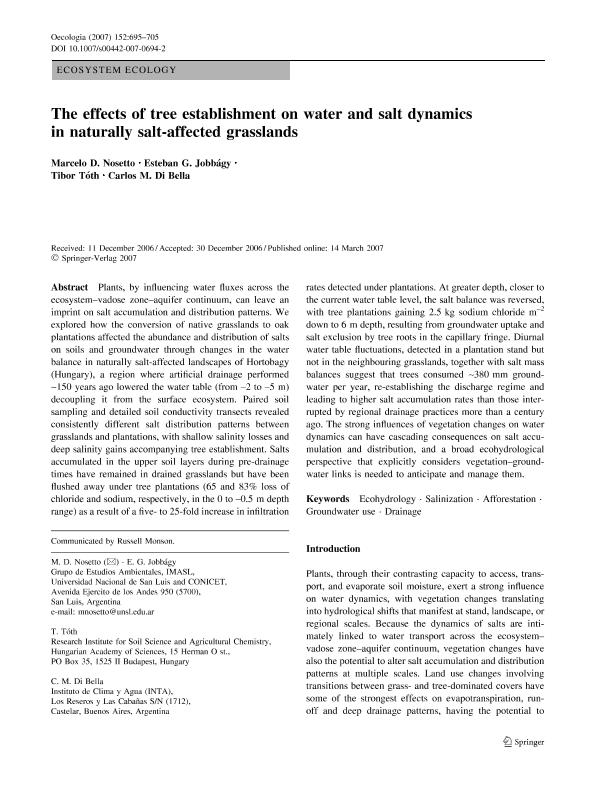Mostrar el registro sencillo del ítem
dc.contributor.author
Nosetto, Marcelo Daniel

dc.contributor.author
Jobbagy Gampel, Esteban Gabriel

dc.contributor.author
Toth, T.
dc.contributor.author
Di Bella, Carlos Marcelo

dc.date.available
2020-11-30T14:21:15Z
dc.date.issued
2007-03
dc.identifier.citation
Nosetto, Marcelo Daniel; Jobbagy Gampel, Esteban Gabriel; Toth, T.; Di Bella, Carlos Marcelo; The effects of tree establishment on water and salts dynamics in naturally salt-affected grasslands; Springer; Oecologia; 152; 4; 3-2007; 695-705
dc.identifier.issn
0029-8549
dc.identifier.uri
http://hdl.handle.net/11336/119341
dc.description.abstract
Plants, by influencing water fluxes across the ecosystem–vadose zone–aquifer continuum, can leave an imprint on salt accumulation and distribution patterns. We explored how the conversion of native grasslands to oak plantations affected the abundance and distribution of salts on soils and groundwater through changes in the water balance in naturally salt-affected landscapes of Hortobagy (Hungary), a region where artificial drainage performed ∼150 years ago lowered the water table (from −2 to −5 m) decoupling it from the surface ecosystem. Paired soil sampling and detailed soil conductivity transects revealed consistently different salt distribution patterns between grasslands and plantations, with shallow salinity losses and deep salinity gains accompanying tree establishment. Salts accumulated in the upper soil layers during pre-drainage times have remained in drained grasslands but have been flushed away under tree plantations (65 and 83% loss of chloride and sodium, respectively, in the 0 to −0.5 m depth range) as a result of a five- to 25-fold increase in infiltration rates detected under plantations. At greater depth, closer to the current water table level, the salt balance was reversed, with tree plantations gaining 2.5 kg sodium chloride m−2 down to 6 m depth, resulting from groundwater uptake and salt exclusion by tree roots in the capillary fringe. Diurnal water table fluctuations, detected in a plantation stand but not in the neighbouring grasslands, together with salt mass balances suggest that trees consumed ∼380 mm groundwater per year, re-establishing the discharge regime and leading to higher salt accumulation rates than those interrupted by regional drainage practices more than a century ago. The strong influences of vegetation changes on water dynamics can have cascading consequences on salt accumulation and distribution, and a broad ecohydrological perspective that explicitly considers vegetation–groundwater links is needed to anticipate and manage them.
dc.format
application/pdf
dc.language.iso
eng
dc.publisher
Springer

dc.rights
info:eu-repo/semantics/openAccess
dc.rights.uri
https://creativecommons.org/licenses/by-nc-sa/2.5/ar/
dc.subject
ECOHYDROLOGY
dc.subject
SALINIZATION
dc.subject
AFFORESTATION
dc.subject
GROUNDWATER USE
dc.subject
DRAINAGE
dc.subject.classification
Ciencias del Suelo

dc.subject.classification
Agricultura, Silvicultura y Pesca

dc.subject.classification
CIENCIAS AGRÍCOLAS

dc.title
The effects of tree establishment on water and salts dynamics in naturally salt-affected grasslands
dc.type
info:eu-repo/semantics/article
dc.type
info:ar-repo/semantics/artículo
dc.type
info:eu-repo/semantics/publishedVersion
dc.date.updated
2020-09-24T17:29:22Z
dc.journal.volume
152
dc.journal.number
4
dc.journal.pagination
695-705
dc.journal.pais
Alemania

dc.journal.ciudad
Berlin
dc.description.fil
Fil: Nosetto, Marcelo Daniel. Consejo Nacional de Investigaciones Científicas y Técnicas. Centro Científico Tecnológico Conicet - San Luis. Instituto de Matemática Aplicada de San Luis "Prof. Ezio Marchi". Universidad Nacional de San Luis. Facultad de Ciencias Físico, Matemáticas y Naturales. Instituto de Matemática Aplicada de San Luis "Prof. Ezio Marchi"; Argentina
dc.description.fil
Fil: Jobbagy Gampel, Esteban Gabriel. Consejo Nacional de Investigaciones Científicas y Técnicas. Centro Científico Tecnológico Conicet - San Luis. Instituto de Matemática Aplicada de San Luis "Prof. Ezio Marchi". Universidad Nacional de San Luis. Facultad de Ciencias Físico, Matemáticas y Naturales. Instituto de Matemática Aplicada de San Luis "Prof. Ezio Marchi"; Argentina
dc.description.fil
Fil: Toth, T.. Hungarian Academy of Science; Hungría
dc.description.fil
Fil: Di Bella, Carlos Marcelo. Consejo Nacional de Investigaciones Científicas y Técnicas; Argentina. Instituto Nacional de Tecnología Agropecuaria. Centro de Investigación de Recursos Naturales. Instituto de Clima y Agua; Argentina
dc.journal.title
Oecologia

dc.relation.alternativeid
info:eu-repo/semantics/altIdentifier/doi/https://doi.org/10.1007/s00442-007-0694-2
dc.relation.alternativeid
info:eu-repo/semantics/altIdentifier/url/https://link.springer.com/article/10.1007/s00442-007-0694-2
Archivos asociados
